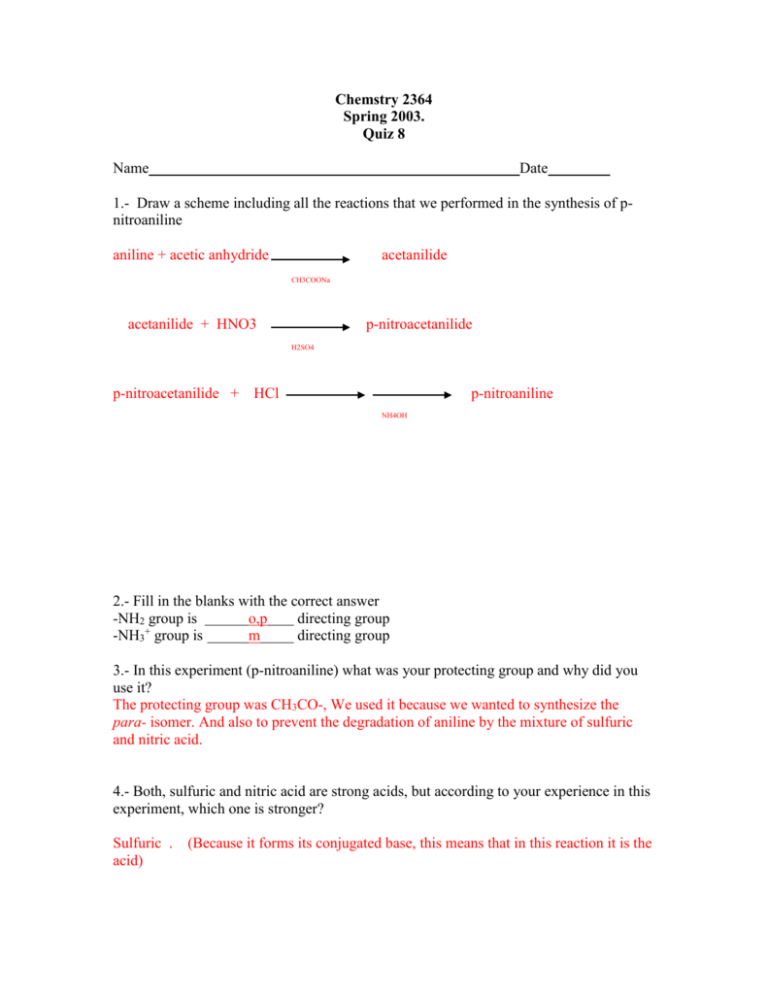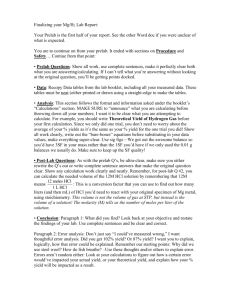Quiz 8 - Tripod
advertisement

Chemstry 2364 Spring 2003. Quiz 8 Name Date 1.- Draw a scheme including all the reactions that we performed in the synthesis of pnitroaniline aniline + acetic anhydride acetanilide CH3COONa acetanilide + HNO3 p-nitroacetanilide H2SO4 p-nitroacetanilide + HCl p-nitroaniline NH4OH 2.- Fill in the blanks with the correct answer -NH2 group is o,p directing group -NH3+ group is m directing group 3.- In this experiment (p-nitroaniline) what was your protecting group and why did you use it? The protecting group was CH3CO-, We used it because we wanted to synthesize the para- isomer. And also to prevent the degradation of aniline by the mixture of sulfuric and nitric acid. 4.- Both, sulfuric and nitric acid are strong acids, but according to your experience in this experiment, which one is stronger? Sulfuric . acid) (Because it forms its conjugated base, this means that in this reaction it is the 5.- The H for the nitration step is a) positive b)negative c) zero d)imaginary e) complex Because it releases heat. H means the change in enthalpy (heat). It is the final minus the initial (like in any chage). In the final state you have something plus some heat released, and in the initial state you just have something. So if you make this (something + heat) –( something), you will see that the something cancels out and you end up with heat. (This is a very simplistic answer, if you wan to learn more check in any general chemistry book in the thermochemistry section) And I realized that I did not ask properly, I only wanted to know if were aware that you have to cool this reaction (nitration), because of the released heat. 6.- Give two examples of o- p- directing groups and two examples of m- directing groups o- p- : -NH2, CH3 (Electron donating groups) m- : -SO3H (electron withdrawing) 7.- In the hydrolysis step you have 1 mole of p-nitroacetanilide and 300 mLof HCL 6N. After the neutralization, you end up with 100 g of p-nitroaniline. What was your % yield? Limiting reagent HCl .3 L (6 Eq/L) = 1.8 Eq (In this Equivalents are equal to moles) The reaction is 1:1 so if I have 1.8 moles of HCl they are in excess respect to my only one mole of p-nitroacetanilide. So, p-nitroacetanilide is the limiting reagent. Theoretical yield 1 mole p-nitroacetanilide 1 mole p-nitroaniline 1 mole p-nitroaniline [138.13 g/ 1 mole] = 138.13 g (I am not so sure of the molecular weight, but if you don’t calculate properly you will not lose points for that in my quizzes. Maybe you can lose point for that in the final) % Yield % Yield = actual yield/ theoretical yield = 100g/ 138.13 g 72.4 % 8.- If the following process NH2 NH2 + NO2 NO2 Occur with a % yield of 30%, and if the % yield of the synthesis we performed are: 1.- Acetylation = 90% 2.- Nitration = 60% 3.- Hydrolysis = 45% Which process will have a higher overall %yield? (show your work) There are two processes to obtain the same product. One is the imaginary process ( it is completely illogical but I just wanted you to compare between the two processes) For the real one we have an overall yield of %yield = %yield step 1 * %yield step 2 * ….. %yield step n = .90 * .60 * .45 = .243 = 24.3% The yield for the single step process is 30%. So it is higher than our 24.3% I just wanted you to realize that even tough it seems that we have good yields in every single step it is better to carry our synthesizes in the lower possible numer of steps. Extra credit. Imagine that your efficiency as a synthetic chemist is 90% for every single reaction you perform (you are really good). Your task is to perform a multi-step synthesis of 20 single steps. What would be your overall yield for this task? %yield = %yield step 1 * %yield step 2 * ….. %yield step n So the % yield is going to be % yield = (0.9)20 = .12 = 12% (Does not seem very poor compared to all your effort during 20 very nice steps?)






